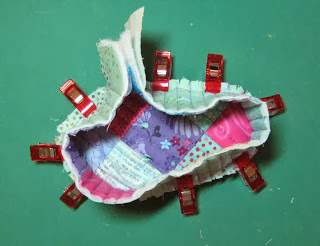
OK, Flickr Friends, quit yer whining, here it is! I made a tutorial for the little green tote. I'm wordy, so get over it. ;) I'm going to assume you have some sewing experience and don't need your hand held the whole way, but I think I give enough instruction for you to muddle thru this. If not, ask me, I'll try to answer you here in the comment section and if your question is REALLY valid, I'll correct the tute. LOL
I recently made myself a
little set of organizing totes to use when I am Mum-sitting. One of the more popular pieces on Flickr is
this little tote with a sliding lid, so I made another one and photographed the
process and made this little tutorial.
Hopefully it'll provide you with enough info to make yourself one.
Ingredients- fabric, 14" zipper (extra long for ease in installing) Insul-Bright or batting of choice, Dritz eyelets- at least 1/4", 1/4" cotton cording, and standard sewing equipment.
Ingredients- fabric, 14" zipper (extra long for ease in installing) Insul-Bright or batting of choice, Dritz eyelets- at least 1/4", 1/4" cotton cording, and standard sewing equipment.
I started out with 2"
squares and a few larger pieces that were the equivalent of 2 squares sewn
together, 2" x 3.5". I laid
them out in a grid that was 5 squares high and 7 squares long, when sewn
together it measures about 8" x 11".
You don't have to piece the fabric for this, you could use a solid
piece, it would save a lot of time. If
you do piece it, alternate the way you press the seams, every other row and
when you sew the rows together, press those seam open. When that's done, square it up. Make another piece that is 3 x 3 squares,(5.5"
x 5.5") for the top and one row that is 8 squares (2" x 13")
long for the brim on the lid, see the photo.
Note- on the 3 x 3 square, use a 3/8" seam allowance for a slightly smaller grid of blocks, this will look nicer. See the green lid? I did that there, but forgot to on the purple one. See the difference? I like the green one better. It doesn't affect the lid in any way, it's just aesthetic.
Note- on the 3 x 3 square, use a 3/8" seam allowance for a slightly smaller grid of blocks, this will look nicer. See the green lid? I did that there, but forgot to on the purple one. See the difference? I like the green one better. It doesn't affect the lid in any way, it's just aesthetic.
Sandwich these pieces with
batting and your lining fabric. I used
Insul-Bright for my batting because it has a stiffness to it that I like, but
you don't have to use that. Quilt in
rows about 3/8" apart On the long
brim piece, don't quilt too close to the ends because you'll need some excess fabric
for seaming, see the photo.
Sew the right edge of the
main piece to the left edge of the zipper, RST, fairly close to the teeth. I use my walking foot for this, it works
great. Then trim away the excess and
fold it back and top stitch, catching the edge of the zipper tape, this encases
all your raw edges. Then do the same for
the other side, being sure to line up the main piece. Trim, finger press it down on the right side
and topstitch, again catching the zipper tape on the back.
Sew a few stitches across the tops and the bottom
so that you can't accidentally unzip the whole thing and end up with the zipper
pull unattached later! Careful stitching
over the teeth, go slowly and don't break a needle or the thread. See the photo. Trim off the excess zipper, top and bottom. Mark the center of the back.
Turn it inside out, line up
the center of the back with the middle of the zipper and sew 1/4" seam
across the bottom. (Careful again over
the zipper!) Cut a strip of fabric to
match the lining 1.5" wide by 7" long. Sew this on over that seam you just sewed,
RST, then turn it over to the other side, press under the raw edge and sew it
down with the machine, to cover all the raw edges. Trim it off at the ends and apply Fray Check
to the cut edges. Let dry a bit and turn
right side out.
(Wow, I got really close to the edge on that zipper tape! Happy accident!)
Make your pattern piece for the top- draw a rectangle 5 1/8" long and 2 5/8" wide. Using a 2.25" circle, round the edges and taper it up to the long sides. This makes a nice oval. It's easy to do, just sounds like a pain. See the photos.
Lay this piece on your
quilted 3 x 3 square, I like to set it diagonally. Cut out your lid piece. See the photos.
OK, are you still with me? Good!
Cut 2 pieces of fabric for
binding for the top edge of the little tote and the bottom edge of the lid
brim. Cut them 1.5" wide by 14"
or so. Sew on binding strip, RST, to the top of
the tote piece using a 3/8" seam allowance, leaving about an inch hanging
over on either end, then turn the short ends in (trim away excess first) and
then fold over the long edges and hand-sew that inside seam down, making it
nice and even. It's such a small project, hand-finishing doesn't take but a
couple of minutes and it's so much nicer than a machine stitch. :)
If you want something inside
your tote to hold tools, you can add this now, like elastic or twill tape. Or you can add it later, it doesn't matter,
but without the lid attached, it's a bit easier to maneuver under the presser
foot.. I'll add mine later once I decide
what I'll use it for, I just pinned it for the photos. Also, tie a small piece of rat-tail onto the zipper pull piece, to make it a lot easier to open the zipper later. Trim and add a dot of Fray Check to the rat-tail. (Ribbon, embroidery floss, etc, anything like that will work.) See the photos.
On the long strip for the
lid brim, trim it so it's straight and then stitch a stay-stitch along one long
edge, 1/4" from the edge. Using
very sharp scissors, clip that seam allowance every 1/4" or so, just up to
the stitched line, to ease in sewing to the oval. See the photos.
Now for the only tricky part
to this whole project- because everyone's pattern piece could differ slightly and your seam allowance might be a little bigger or smaller than mine, I can't
give you a definitive length for the brim piece. So, starting on one of the
long sides of the oval, baste the brim piece to the oval. I hand-baste this, I have much more control
that way. Those little notches you cut
make this easier, but it's still pretty twitchy work. Pins or clips might help.
Start basting near a curve, leaving a couple
inches of the piece unsewn for now, 1/4" seam allowance. Work
your way all the way around until you get back to the long side- leave about
2.5" unstitched- and then see where your 2 short edges are going to
meet. You want the batting to butt
against the other piece of batting, not overlap.
Trim away the excess batting but not the
fabric. Fold the fabric over the batting
and press, to get a line for sewing on. Once you're confident it's all going to
work out, sew that seam, trim and press open with your fingers. Then you can trim the lining piece and sew it
down by hand. Then finish basting the
brim to the lid. Once that's all done
and you're happy with it, you can machine sew over your basting line with a
zipper foot. See the photos.
Apply the other piece of 1.5"
x 14" binding piece to the brim, RST, and hand-finish it, turning the short edges under
where they join and sewing a short seam.
This is a little fiddly, too, as you're working in a small space.
The inside- fairly bulky seam allowance.
Now the top is nearly done, it only
needs 2 eyelets inserted! Those are easy
to do, follow the instructions on the package.
You can mark where to cut just by pushing hard on the metal piece, but I
used a pen for the photos. I had some Dritz Large Eyelets on hand, they are marked 1/4", so that's what I used after making sure that my covered cording would pass thru the hole.
Put them
right near the outside edge, in the center of the lid, but leave at least
1/8" of space on the side because you'll have a fairly bulky seam
allowance under there. See the photos. If you clipped thru quilting, a dot of Fray
Check might be a good idea.
The last thing to do is to
make the covered cord handle. I used
1/4" Wright's Cotton Cording for this one, but the original one is
slightly thicker, probably 5/16" cording.
I prefer the thicker, but make sure it'll go thru the eyelets!
Cut 20" of BIAS material, 2" wide. Using 40" of cording, and starting in
the middle, using a zipper foot, sew the material around the cording by
stitching thru the material and the cording and then turning and running down
the length of it. Trim the excess off,
and then pull the cording and shove the fabric up over the cording at the top. See the photos. Be sure you sew thru the cording when you start, to lock the fabric to the cord. You'll be pulling pretty hard and don't want this to break away. PS- You have to have twice as much cording
material than you actually need for the project for this to work. See the photos.
Tie a knot in one end, trim
and apply Fray Check.
Determine how long
you want your handle, adding enough length for another knot. Feed the cord thru the eyelets in the lid and
tie the other knot, trim, Fray Check.
Using a hidden stitch, sew the
ends with the knots inside the little tote. See the photos.
It's done! It was pretty easy, wasn't it? And you'll NEVER lose the lid to this little
tote!
Now I have another little matching set! And see my little pin holder? I needed a flat pincushion for my sewing book.
You can make yourself one with a bit of cork and a piece of cardstock and some tacky glue!
I hope you enjoyed this tutorial. Sorry if it's too wordy or has too many photos, but I try to be thorough. Have fun making little totes! Please don't make a pattern off of this tute and sell it as your own. This was my original idea and pattern and I'd appreciate it if you'd link back to me if you do make this, give a little credit where it's due. Thanks!







































































